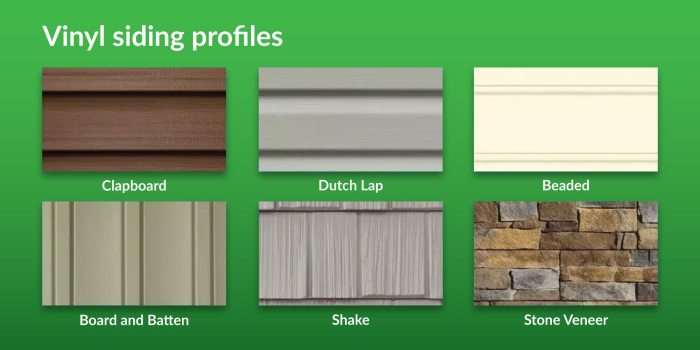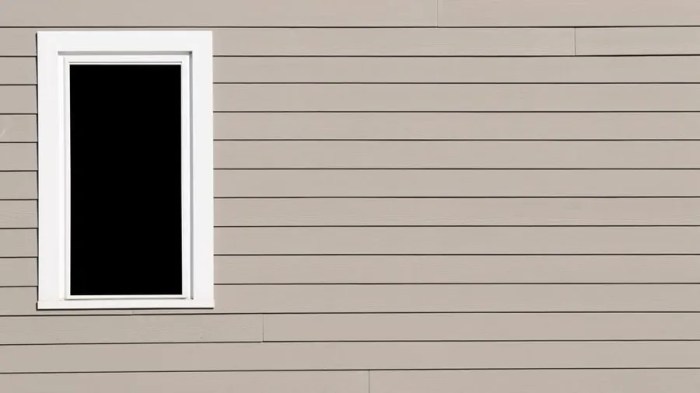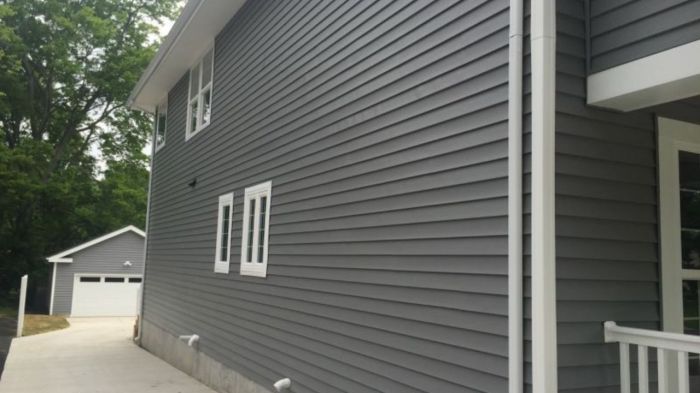Cost to Replace One Piece of Vinyl Siding

Cost to replace one piece of vinyl siding? It sounds simple, but the price can vary wildly. Factors like the siding type, your location, and even the accessibility of the area all play a role. We’ll break down the costs, from materials to labor, helping you understand what to expect whether you’re tackling this DIY or hiring a pro.
This guide covers everything from estimating material costs (including those pesky matching pieces!) and labor rates to navigating the process of finding a reputable contractor. We’ll even equip you with the knowledge to avoid unexpected expenses and potential DIY pitfalls. Get ready to become a vinyl siding replacement expert!
Factors Affecting Replacement Cost

Source: forbes.com
Replacing a single piece of vinyl siding might seem like a small job, but the cost can vary surprisingly. Several factors influence the final price, making it crucial to understand these variables before starting the project. This will help you get a realistic estimate and avoid unexpected expenses.
Labor Costs
Labor costs are a significant portion of the overall expense. A contractor will charge by the hour or per job. The complexity of the replacement – whether it involves removing and reinstalling surrounding pieces, or just swapping out the damaged piece – will influence the time required, and therefore the cost. For a simple replacement, labor might be relatively inexpensive, perhaps a couple of hours’ work. However, if the damaged piece is hard to reach (e.g., high up on a two-story house) or requires extensive preparation work, the labor cost can increase substantially. Consider also the contractor’s experience and reputation; more experienced contractors generally charge more per hour.
Material Costs
The cost of the replacement vinyl siding piece itself depends heavily on the type and quality of the siding. Premium vinyl siding, which often features enhanced durability, colorfastness, and thicker profiles, will cost more than standard siding. The color of the siding can also affect the price; some colors may be more expensive to produce. You’ll also need to factor in the cost of any necessary fasteners or caulking.
Location and Access Difficulties
The location of the damaged siding piece plays a role in the cost. Replacing a piece on the ground floor is far easier and quicker than replacing one on a second story or a hard-to-reach area. Access difficulties, such as overgrown landscaping or obstacles around the house, can also add to labor costs as the contractor needs more time to navigate the area safely. For example, if scaffolding is needed to access a high area, this will significantly increase the overall expense.
Comparison: Single Piece vs. Larger Section
Replacing a single piece is typically much cheaper than replacing a larger section. The cost difference can be substantial. While a single piece might cost a few hundred dollars, replacing several pieces, or even a whole section of siding, could easily reach into the thousands. This is primarily due to the increased labor involved in a larger-scale project.
Impact of Siding Age and Condition
The age and condition of the existing siding can influence replacement costs. Older siding may be more difficult to remove, requiring more time and effort. If the surrounding siding is also in poor condition, the contractor might recommend replacing more than just the damaged piece to ensure consistency and longevity. This can, of course, increase the overall cost. Conversely, if the surrounding siding is in good condition, the replacement might be a simpler and less expensive process.
Cost Comparison of Vinyl Siding Types
| Siding Type | Material Cost (per piece) | Labor Cost (estimated) | Total Cost (estimated) |
|---|---|---|---|
| Standard Vinyl Siding | $5 – $15 | $50 – $150 | $55 – $165 |
| Premium Vinyl Siding | $15 – $30 | $50 – $150 | $65 – $180 |
*Note: These are estimates and can vary significantly based on location, contractor, and specific project details.
Material Costs: Cost To Replace One Piece Of Vinyl Siding

Source: homedit.com
Replacing a single piece of vinyl siding might seem like a small job, but understanding the material costs is crucial for accurate budgeting. The price can vary significantly depending on factors like the siding’s quality, color, and texture, as well as where you purchase it from.
The cost of a single vinyl siding panel is influenced by many factors. Let’s explore these to give you a clearer picture.
Single Vinyl Siding Panel Price Range
A single replacement vinyl siding panel typically costs between $5 and $30. Lower-end options, often found in basic colors and smooth textures, fall closer to the $5-$10 range. Higher-end panels, featuring more intricate textures (like wood grain or stone) and premium colors, can easily reach $20-$30 or more per piece. These prices are estimates and can fluctuate based on regional differences and current market conditions. For example, a standard white panel might cost around $8, while a deeply textured, dark brown panel could be closer to $25.
Cost of Matching Existing Siding
Finding an exact match for older siding can be challenging. If your original siding is discontinued, you might encounter additional costs. You may need to purchase multiple panels to find a close enough visual match, potentially increasing your overall expense. In some cases, you might even need to consider repainting or restaining nearby panels to blend the new piece seamlessly, further adding to the cost. For instance, if you need to buy five panels to achieve a satisfactory match instead of one, your cost will increase fivefold.
Home Improvement Store vs. Specialized Siding Supplier
Purchasing from a large home improvement store offers convenience but may result in higher prices per panel compared to specialized siding suppliers. Home improvement stores often cater to a broader range of customers, which can inflate prices. Specialized suppliers, on the other hand, typically focus solely on siding and related products, often allowing for more competitive pricing, especially on larger orders. While a home improvement store might charge $10 for a panel, a specialized supplier could offer the same panel for $8, or even less depending on volume.
Additional Materials Needed for Repair
It’s important to remember that replacing a single vinyl siding panel isn’t just about the panel itself. You’ll also need other materials to ensure a proper and lasting repair.
- Nails: Galvanized roofing nails are recommended for their corrosion resistance and hold. You’ll likely need several nails per panel.
- Caulk: Exterior-grade caulk is essential to seal gaps and prevent water intrusion around the edges of the new panel.
- Sealant: A high-quality sealant provides added protection against moisture and air leakage.
- Primer (Optional): If the surrounding siding needs touch-up painting, you might need a primer for optimal paint adhesion.
Labor Costs

Source: estimatorflorida.com
Replacing a single piece of vinyl siding might seem like a small job, but the labor costs can vary significantly depending on several factors. Understanding these costs will help you budget accurately and decide whether to tackle the repair yourself or hire a professional.
Professional siding contractors typically charge hourly rates ranging from $50 to $100 or more, depending on their experience, location, and the complexity of the job. While replacing a single piece seems straightforward, the actual time spent often includes travel, material acquisition, and the necessary prep work. This is where the true cost of professional labor becomes apparent.
Professional vs. DIY Repair Cost Comparison
Hiring a professional usually means a higher upfront cost, but it comes with the benefit of expertise and efficiency. Professionals possess the skills and tools to complete the repair quickly and correctly, minimizing the risk of further damage. A DIY approach might seem cheaper initially, but mistakes can lead to more extensive and costly repairs down the line. For example, incorrectly installed siding can lead to water damage, requiring more extensive and expensive repairs. Consider the cost of your time as well – a professional will likely complete the job in a fraction of the time it would take you, potentially making the professional option more cost-effective in the long run. Factor in the cost of tools, which you may need to purchase or rent. The total cost of a DIY repair, including potential mistakes, could easily exceed the cost of hiring a professional.
Hidden Labor Costs
Beyond the hourly rate, several hidden labor costs can add up. Waste disposal is one example. Professionals will charge extra to properly dispose of old siding and other debris, adhering to local regulations. Site preparation is another factor. This could involve cleaning the area around the damaged siding, protecting surrounding areas from damage, and setting up scaffolding or ladders for safe access. These seemingly minor tasks contribute to the overall labor expense.
Potential Complications Increasing Labor Costs
Several complications can significantly increase labor costs. Difficult access, such as high-up areas requiring specialized equipment or extensive scaffolding, will naturally inflate the price. Underlying damage to the house’s sheathing or fascia board beneath the damaged siding will necessitate additional repairs and increase the overall time commitment, and therefore cost. Severe weather conditions can also delay the project, adding to labor expenses. If the damaged siding is part of a larger area needing attention, the contractor might need to repair multiple pieces, driving up the cost. Finally, unforeseen issues like rot or insect infestation discovered during the repair process will add extra time and expense. For instance, a seemingly simple siding replacement might uncover water damage requiring extensive repairs to the underlying structure.
DIY Replacement Considerations
Replacing a single piece of vinyl siding yourself can save you money, but it requires careful planning and execution. This section outlines the steps, tools, and potential challenges involved in a successful DIY siding repair. Remember, improper installation can lead to further damage and compromise the overall integrity of your siding. Always prioritize safety and, if unsure about any step, consult a professional.
Steps Involved in DIY Vinyl Siding Replacement
Replacing a single vinyl siding panel involves a series of precise steps to avoid damaging surrounding pieces. Each step requires patience and attention to detail. Improper removal or installation can easily cause damage to adjacent panels or the underlying structure.
- Preparation: Begin by carefully assessing the damaged panel and the surrounding area. Take photos to aid in the reinstallation process. Note the location of nails and any special features (like J-channels or trim). Gently pry away the damaged panel starting at the bottom, working your way up. Be mindful not to bend or break the adjacent panels. You should see the nails holding the siding in place.
- Removal: Using a pry bar or flathead screwdriver, carefully remove the nails securing the damaged panel. Work slowly and methodically, avoiding excessive force. Once the nails are removed, the panel should slide out relatively easily. Expect to see the nail holes and possibly some underlying sheathing.
- Installation of the New Panel: Carefully align the new panel with the surrounding siding. Start at the bottom, ensuring it’s properly seated and aligned with the existing panels. Use new nails of appropriate length, spacing them evenly along the top and bottom edges of the panel. Avoid driving the nails in too deeply, which could damage the panel.
- Securing and Finishing: Once the new panel is in place, gently tap it into position using a rubber mallet to ensure a snug fit. Inspect the panel for proper alignment and any gaps. If necessary, make minor adjustments. The final result should look seamless and indistinguishable from the surrounding siding.
Necessary Tools and Equipment
Having the right tools is crucial for a smooth and efficient repair. The wrong tools can lead to damage or injury. Always prioritize safety and use appropriate personal protective equipment (PPE) such as safety glasses.
- Pry bar or flathead screwdriver.
- Hammer
- Measuring tape
- Utility knife
- Safety glasses
- Work gloves
- Replacement vinyl siding panel (matching color and style)
- Nails (appropriate length and type for vinyl siding)
- Rubber mallet (optional, but recommended)
Potential Risks and Challenges of DIY Vinyl Siding Replacement
While a DIY approach can be cost-effective, there are inherent risks. Improper technique can lead to significant damage and increase repair costs.
One of the primary risks is damaging the surrounding siding. Excessive force when removing or installing the panel can crack or bend adjacent pieces. Another potential issue is improper nail placement, leading to gaps or water infiltration. Furthermore, if you lack experience, you may misjudge the needed panel size or type, leading to further complications and added costs. Finally, the possibility of personal injury exists, particularly if you are not comfortable working at heights or using tools properly.
Finding a Contractor

Source: fixr.com
Finding the right contractor for your vinyl siding replacement is crucial for a successful project. A reputable contractor will not only do a quality job but also protect you from potential problems down the line. Thorough research and careful vetting are key to ensuring a smooth and satisfactory experience.
Finding qualified siding contractors involves a multi-step process. Begin by gathering recommendations from friends, family, and neighbors. Online searches, using platforms like Yelp or Angie’s List, can also yield promising leads. Check contractor review sites and pay attention to both positive and negative feedback. Look for contractors with consistent positive reviews and a history of resolving any negative experiences professionally.
Contractor Qualification and Pricing
Before contacting any contractor, create a list of questions to assess their qualifications and pricing practices. This helps filter out less-than-ideal options early on. Examples of crucial questions transformed into informative statements include: The contractor should hold a valid license and insurance, demonstrating their legitimacy and commitment to protecting you from liability. Their experience should encompass numerous similar projects, proving their proficiency in vinyl siding installation. They should provide detailed, itemized quotes, clarifying the breakdown of labor and material costs. Their payment terms should be clearly defined, preventing misunderstandings. A detailed timeline for the project should be provided, setting realistic expectations. They should offer a warranty on both materials and workmanship, ensuring long-term protection. The contractor’s communication style should be professional and responsive, ensuring smooth collaboration.
Comparing Contractor Quotes
Once you have a few quotes, comparing them is essential. Don’t solely focus on the lowest price. Instead, consider the overall value. Create a table to compare different aspects. For example:
| Contractor | Total Cost | Materials Used | Warranty | Experience | Insurance | Payment Terms | Timeline |
|---|---|---|---|---|---|---|---|
| Contractor A | $5000 | CertainTeed | 10 years | 15 years | Yes | 50% upfront, 50% upon completion | 2 weeks |
| Contractor B | $4800 | Generic Brand | 5 years | 5 years | Yes | Full payment upon completion | 3 weeks |
Analyzing this table, you might find that while Contractor B is slightly cheaper, Contractor A offers superior materials, a longer warranty, and more experience, representing a better long-term value despite the slightly higher initial cost.
Contractor Selection Checklist, Cost to replace one piece of vinyl siding
Choosing a contractor involves several key considerations. A comprehensive checklist includes verifying the contractor’s license and insurance. Assessing their experience through reviews and references is crucial. Requesting and comparing detailed quotes with a clear breakdown of costs is necessary. Confirming the payment terms and understanding the project timeline are vital. Checking for guarantees and warranties on materials and labor protects your investment. Finally, ensuring clear and consistent communication with the contractor ensures a smooth project execution. Ignoring any of these points can lead to costly mistakes and dissatisfaction.
End of Discussion
Replacing a single piece of vinyl siding might seem minor, but understanding the associated costs is key to a successful repair. Whether you opt for DIY or professional help, remember to factor in materials, labor, and potential complications. By carefully considering these aspects and using the information provided here, you can confidently tackle this project and keep your home looking its best. Remember, a little preparation goes a long way!
Comments are closed.